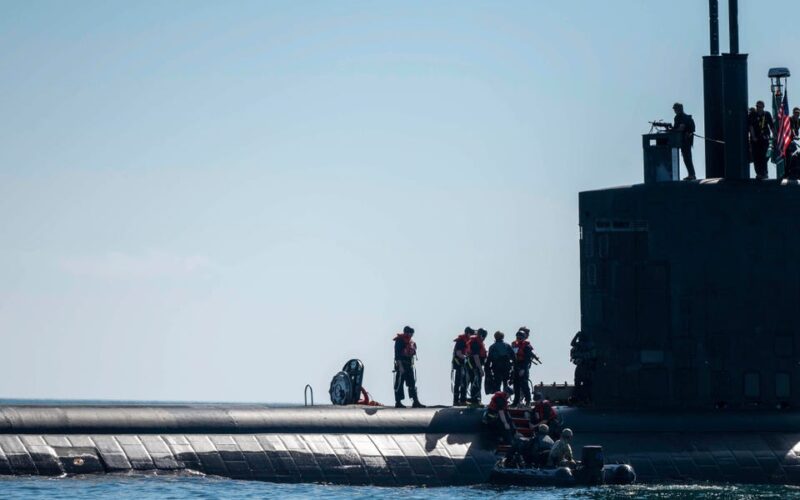In the event of a conflict with China or Russia, the Naval Special Warfare community is expected to have an even larger role than it had during the counterterrorism and counterinsurgency campaigns of the Global War on Terror (GWOT).
With the majority of the world covered by water, including oceans, lakes, and rivers, Navy SEALs and Special Warfare Combatant-Craft Crewmen (SWCC) operators are expected to be at the tip of the spear of the special operations community in a potential conflict with Beijing or Moscow.
This community, however, will need to operate with conventional forces, such as submarine crews.
Earlier in the summer, Navy SEALs assigned to West Coast SEAL Teams worked with the Los Angeles-class attack submarine USS Greeneville in fleet interoperability training to boost their ability to fight together in the maritime domain.
The SEALs flew in close to the submarine’s position before conducting a military freefall parachute jump. They then used inflatable combat rubber raiding crafts to rendezvous with the sub at a designated location.
Petty Officer 1st Class Alex Perlman
“This training opportunity provided the submarine warfighters aboard USS Greeneville the opportunity to practice a unique capability,” Navy Capt. Kenneth Douglas, the commanding officer of Submarine Squadron 11, said following the end of the exercise.
USS Greeneville is assigned Submarine Squadron 11 and would be, in the event of a conflict, tasked with sinking enemy warships and transport vessels, in addition to leveraging its ability to carry special operators.
“Expanding joint interoperability capabilities effectively demonstrates our asymmetric advantage on and under the world’s oceans and I look forward to continued training events with our Naval Special Warfare operators,” the sub’s commanding officer said.
Petty Officer 1st Class Alex Smedegard
Submarine operations are a great option to clandestinely transport small teams of special operators close to a target. Regardless of the specific mission of the special operations team — it can be a special reconnaissance mission, direct action raid, sabotage operation, hostage rescue, or personnel recovery operation — submarine operations promise secrecy and security.
A war with China would involve a lot of naval action, and the combination of submarines and Navy SEALs could allow the US military to reach behind the Chinese lines and impose heavy costs as rapidly deployable and potentially deniable forces.
Petty Officer 1st Class Alex Perlman
Navy Capt. Blake L. Chaney, Commander, Naval Special Warfare Group 1, said after the recent exercise that “by synchronizing our operations, activities and investments, we not only bolster fleet lethality but also provide substantial value in securing access to either denied or contested areas.”
The Navy’s Virginia-class nuclear-powered attack submarines are equipped with specialized compartments that can host special operators, as well as facilitate their ingress and egress from target areas.
Petty Officer 1st Class Alex Perlman
“We’ve always worked with Big Navy. GWOT made it harder to work with submarines, but I’m sure that’s changed now,” a former Navy SEAL operator who now works for the federal government told Business Insider.
“Submarine ops are great because they present a great way to approach a target. If everyone follows procedures, infiltrating to and exfiltrating from a target [through] a submarine is a great option to have,” the former frogman, who spoke on the condition of anonymity because of his sensitive work, added.
“Sub ops certainly present difficulties. There are strict procedures that everyone, crew and operators, need to follow to the letter. Otherwise, what would be an asset quickly becomes a liability,” he said.
Petty Officer 1st Class Alex Smedegard
Frogmen always swim in pairs and tied with a rope so that no one gets lost or left behind. In January, Navy Special Warfare Operator 2nd Class Nathan Gage Ingram showed how seriously SEALs take this when he jumped into the dark waters of the Arabian Sea after his teammate, Navy Special Warfare Operator 1st Class Christopher J. Chambers, slipped and fell as they were boarding a suspect Houthi vessel. Both frogmen died.
Interestingly, the Navy doesn’t work solely with SEALs. Army Green Berets, Marine Raiders, and Recon Marines also have a combat diver capability. Indeed, Marine Raiders were the first unit in the US military’s history to use a submarine to get to their target for an assault against the Japanese garrison at Makin Island in 1942.
However, the main difference between these units and Navy SEALs is that the former use combat diving to get to the shore and conduct their normal mission sets, whereas the latter use combat diving to both get to the shore to attack enemy positions and conduct underwater reconnaissance.
Source link
lol

